

Pierwsze kroki z programowaniem. Szczegóły Opublikowano: poniedziałek, 20, kwiecień 2015 00:00 Krystyna Kużmin-Smalc Do realizacji projektu „Mistrzowie Kodowania” przymierzałam się dość długo.

Pracuję z trzema klasami pierwszymi (sześcio i siedmiolatki), więc wyzwanie duże. Obejrzane wspólnie na scratch.mit.edu przykładowe efekty pracy starszych kolegów wzbudziły u dzieci wiele entuzjazmu i wiele wątpliwości u mnie. Pułapka za pułapką. Krok za krokiem pokonujemy napotkane trudności. APLIKACJE - Strona internetowa 123tablety! With A Brooklyn Accent: BATS and the Pedagogy of Joy. Witamy na polskich stronach projektu EU-HOU !!! Profesor.pl - publikacje nauczycieli, awans zawodowy, scenariusze lekcji, wypracowania, testy, konspekty, korepetycje, matura, nauczyciele. Blog grupy Superbelfrzy RP - eduzmieniaczy. Home. Meshing GBL With PBL: Can It Work? Project-based learning has essential components that make it unique to other models of instruction, such as public audience, voice and choice, driving questions, and teaching and assessing 21st-century skills.
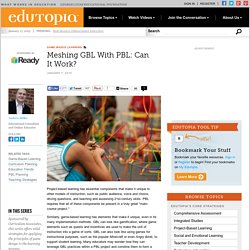
PBL requires that all of these components be present in a truly great "main-course project. " Similarly, game-based learning has elements that make it unique, even in its many implementation methods. GBL can look like gamification, where game elements such as quests and incentives are used to make the unit of instruction into a game of sorts. Weebly: Create a Free Website, Online Store, or Blog. K-12 Education Tips & Strategies That Work. Social Media in the Classroom: 16 Best Resources for 2015. Social media is a powerful tool for keeping in touch with friends, getting coupons and deals from your favorite businesses, and seeing what your favorite celebrities are up to.

It is also handy in your classroom; platforms like Instagram, Twitter, Facebook, and others have the power to help you forge closer connections with students and parents and enhance the educational experience in your classroom. How can you make it happen? Let the following resources lead the way. Is Social Media Right for Your Classroom? Just because your fellow educators are using social media doesn’t mean you should jump blindly on the bandwagon. A piece from Edutopia explains that social media is a unique form of communication that can accomplish multiple goals.
Striking a Balance: Guidelines for Using Social Media Safely and Effectively How can you maintain appropriate student-teacher relationships on social media? Make the Most of Social Media Image via Flickr by MsC’sClassroom In Short. 8 classroom uses for holographic technology. Eliciting engagement and creating excitement among learners is every educator’s raison d’être.
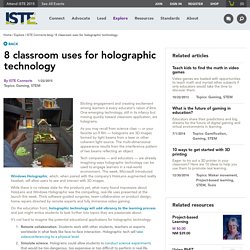
One emerging technology, still in its infancy but moving quickly toward classroom application, are holograms. As you may recall from science class — or your favorite sci-fi film — holograms are 3D images formed by light beams from a laser or other coherent light source. The multi-dimensional appearance results from the interference pattern of two beams reflecting an object. Tech companies — and educators — are already imagining ways holographic technology can be used to engage learners in a real-world environment.
This week, Microsoft introduced Windows Holographic, which, when paired with the company’s HoloLens augmented reality headset, will allow users to see and interact with 3D images. While there is no release date for the products yet, what many found impressive about HoloLens and Windows Holographic was the compelling, real-life uses presented at the launch this week. What I Learned About Dealing with People From Playing Games Online. 5 Things Every Teacher Should Be Able to Do On YouTube. January, 2015 After the post I shared here on how to create flipped videos via the use of annotations and other interactivity features on YouTube, I received a couple of emails from fellow teachers asking about certain functionalities on YouTube.
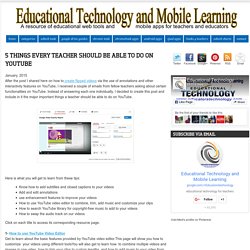
Instead of answering each one individually, I decided to create this post and include in it the major important things a teacher should be able to do on YouTube. Here is what you will get to learn from these tips:Know how to add subtitles and closed captions to your videosAdd and edit annotationsuse enhancement features to improve your videosHow to use YouTube video editor to combine, trim, add music and customize your clipsHow to search YouTube library for copyright-free music to add to your videosHow to swap the audio track on our videos Click on each title to access its corresponding resource page. Learn to Code for Teachers Part 3, or How I Spent My Summer Vacation - Technology In Early Childhood.
So this is the third and final installment in my Learn to Code: For Teachers series.
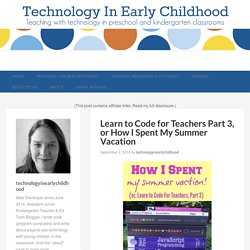
See that stack of books in the picture above? That’s my stack of books, and I read them all this summer. I know, it’s not quite your average stack of of summer beach reads. It certainly isn’t what my summer reading stack has looked like any other summer. Usually I have a couple novels, a parenting book or two and whatever book our faculty is reading together as a group. By Rosalind Wisemen as a faculty and I can’t recommend it highly enough, especially if you’re parenting a boy.) This year, I devoted my summer to learning to program computers. I’m fortunate to live close to one of the top computer science universities in the country. Technology In Early Childhood - Teaching with Technology in Kindergarten and Pre-school Classrooms.
Traditional toys like jigsaws and Lego boost children's problem solving skills. Instead the experiments by psychologists from Rhodes College in Memphis, USA, suggest getting children as young as four to make things from Lego or do a jigsaw instead.
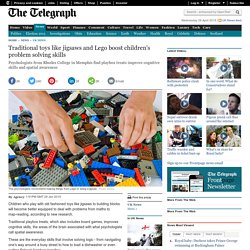
Psychological scientist Jamie Jirout and team analysed data from 847 children aged 4-7 from across America who had taken a commonly used IQ test for youngsters. It then looked at the home life of the children to find those who did best were more likely to play with traditional toys at home rather than sitting in front of a screen all day. Cognitive skills form a large part of the test - matching shapes and patterns for instance - and those who played with such toys six times a week or more did best of all. However, it does not mean all traditional forms of play are better for spatial awareness, said the researchers.